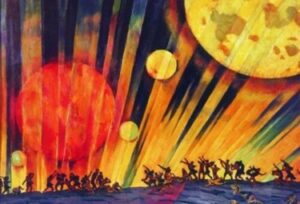‘A cosmogonic Hindu tale relates: “There lived long ago a terrible monster who devoured people. Once the monster was pursuing an intended victim and the man, seeking to save himself, plunged into a lake. The monster sprang after him, but the swimmer threw himself on the back of the monster and took firm hold of its projecting crest. The monster could not turn over on its back because its belly was unprotected. It rushed about in a furious course, waiting for the man to become exhausted. But the thought came to the man that, in maintaining his desperate plight, he was saving humanity, and with this pan-human thought his strength became unlimited and inexhaustible. The monster, meanwhile, increased its speed until sparks formed a fiery wake. Amid flames the monster began to rise above the earth. The universal thought of the man had uplifted even the enemy.
When people see a comet they give thanks to the valiant one, eternally striving, and the thoughts of the people speed outward to give new strength to the rider of the monster. White, yellow, red, and black people direct their thoughts to him who long ago became fiery.”
Strive to the guiding thought about help to humanity. Think clearly that you are performing not a personal act, nor a group act, but an absolutely useful act. That done by you timelessly and without the limitation of space becomes a labor for the unification of the worlds. Preserve this guiding fiery thought. […]’ [1]
In the first year of the sixth Septennium we dedicate this “appointment” of etymosophy to the word “salvation”, because it is a central concept of the Goal that marks its apex, the New World Religion.
This word is so lofty that it provokes some awe, first of all because it projects us with a leap into the idea of custody of Life, and then because its predominantly written use preserves the courtly and dignified profile immortalised by Dante in his Comedy, when he alludes to Paul – Vase full of grace – who would have gone to the afterlife to sustain that faith which is the origin of the way of salvation:
[…] Afterwards Paul, the Chosen Vessel, went there,
to bring confirmation of the faith
that is the entrance to the way of salvation. […] [2]

So let’s now explore this uncommon word, in order to nurture an attitude of greater familiarity and understanding.
It derives from the late Latin salvatio, “salvation of the soul”, a term born in the Christian context, in the ecclesiastical written language: the same name of Jesus derives from the Greek Jesus, through the Hellenistic Greek Iēsus, from the Aramaic Yeshua, which in Hebrew is Yĕhoshūa, “Saviour”. Appropriately, this name is composed of the particle Yah, which indicates “God” and yasha, a word that expresses “salvation”: it literally means “God [is] salvation”. The Gospel of Matthew narrates that the Angel of the Lord who appeared to Joseph in a dream tells him that Mary “shall bring forth a son; and thou shalt call his name Jesus; for it is he that shall save his people […]”. [3]
Salvatio derives from salvare, to save, to heal, a verbal form scarcely used in classical Latin, which with the substantive salus, on the other hand very widespread, meant both health, physical safety and spiritual salvation, with particular reference, speaking of the latter, to the ceremonies of the Mysteries. The word therefore had a much wider meaning than the one preserved in present-day languages and, if personified, even indicated a divinity, the goddess Salus: she was represented seated on a throne, with her right hand in the act of holding a particular platter used in sacred ceremonies, from which she fed a snake whose coils wrapped the altar.
The original Indo-European root is *SAL-, which expresses the idea of integrity, wholeness, interrelation; some linguists also reconnect the word “solid” to it, with the sense of something that is whole. The Sanskrit sarvas (all, whole), sarvatati (integrity, safety), the Greek olòs (whole), from sòlϝos (with an initial thick accent that replaces the original “s” and with the fall of the intervocalic digamma) derive from this root. It is interesting to note that the Greek develops, from the same root *SAL-, together with the older olòs (whole), also the term sotér, saviour.
English also derives from this same root two terms with a similar meaning but with different nuances: whole and safe, which appeared later.
Let us note here in an extremely synthetic way that soteriology (from the combining of the Greek terms sotería, salvation, and logos) or “doctrine of salvation” is central to any manifestation of spirituality, from the origins of the so-called “magical thought” in the mystery rites to the various philosophical-religious systems of the planet.
In the language of Christianity, the use of the term “salvation” has prevailed, indicating the mission of helping man to reunite with the divine – while the concept of liberation from sin, which is affirmed in certain Lutheran and Catholic interpretations, arguing with one another, is reductive – and the word “salvation” was reintroduced in the theosophical context to reaffirm its grandiose significance, distinguishing it from the restrictive meanings of the term “salvation”/salus, affected by different partisan groups.

We would like to highlight the importance of having discovered that the core of this word expresses, etymologically, the primary idea of wholeness, of “being one”, because this synthetic vision offers us the key to find our way in understanding the concept, just like the pan-human thought does, the thought of the unification of worlds, which is expressed with immediacy by the legend presented at the beginning.
The idea of salvation is revealed in a dazzling way by the evolutionary motto of Pisces: “I leave the Father’s home and turning back, I save”, which synthetically expresses the great epic of Man, from renouncing the life of the Monad or spiritual Unity, his homeland (“the Father’s home”), in order to sink into the density of matter, to the salvific relinquishment of form and personality, in order to rejoin the One from whom his being emanated. “[…] Such is the climaxing story of Pisces. The Lords of Will and Sacrifice come down into manifestation, sacrificing their high position and opportunities upon the higher planes of manifestation in order to redeem matter and raise the lives by which it is informed (the lower Creative Hierarchies) to the status of Themselves in so far as They constitute the fourth Creative Hierarchy. This is the subjective purpose, underlying the sacrifice of these divine Lives Who are ourselves essentially, Who are qualified by knowledge, love and will, and animated by ceaseless persevering devotion. They seek to bring about the death of the form in its occult significance and the consequent release of the indwelling lives into a higher state of consciousness. […]” [4]
We can find expressed in these lines the ideal of Brotherhood, which here expands from the concept of collaboration and solidarity in the context of the One Humanity to the immense one of support of the Life among all worlds and all kingdoms, from lowest to highest.
An enlightened Thinker wrote: “[…] the fourth kingdom, the human one, is twofold: in fact, man is both soul and animal. He therefore reacts to the third and fourth kingdom. He’s between one and the other, but it would be more correct to say that he is crucified. This special condition defines his function, his raison d’être, the magisterium: he listens to both the excited voices of the lower kingdoms and the murmur of the world of Ideas. […] For the divine correspondences between high and low, nothing exists that is not spiritual. […]” [5]
Salvation therefore indicates the role of the full human dignity, the complete self-awareness of the worlds of which it is an expression, and the consequent understanding of the idea of universal brotherhood: we can even accept this concept as an appeal to a total dedication to this magisterium that questions and calls us, to this spiritual responsibility which belongs to us as Human Beings, the fourth creative Hierarchy. [6]

In summary, Man, becoming aware of his own nature, aims at penetrating the mystery of Reality, recognising its unitary vital principle, and in this longing he draws with him the three kingdoms of nature which are lesser brothers, in himself and in the external manifestation, accomplishing the work of salvation that is appropriate to him and which is a task that only he can fulfil, as an intermediary between Heaven and Earth.
Let us also remember that the mantrika shakti, the “Incarnate Word”, the spatial energy of Language, is assigned to the fourth creative Hierarchy, and that the term man, which in Sanskrit means “to think” – a sound preserved in German and English to indicate the human being – arises combining the phoneme m, that expresses the idea of “relationship” and the phoneme an, which expresses the idea of vital breath, of soul: Man, the Thinker, is “the breath of the relationship between worlds”. Only when man has the perception of the wholeness and unity of what is Real can he become truly aware of his salvific role as a “relationship”, as a connecting factor, an intermediary.
The opposite concept to that of salvation is therefore not “perdition”, as one might superficially think, but “separativeness”: the exercise of consciously observing our own attitudes can act as a litmus test for the understanding gained along the pilgrimage on the way of salvation, a powerful idea that deeply conquers us, attracts us and enlightens us for its inclusiveness, urging us human beings to think out of love in order to contribute to the divine plan.
Connected to the concept of salvation is also that of liberation, which similarly has a very broad meaning, but can be understood at first instance, in this context, as a release from the limits of experiences in the densest substance, on the path enlivened by the fire of the manas or abstract mind, resonating with the worlds of the elder Brothers.
Let us conclude with two excerpts from Agni Yoga:
When humanity will come to understand the Cosmic Oneness, the cosmic construction will be affirmed. The chief task of humanity is to unite the world of matter with the world of spirit. […] [7]
[…] A summons to unification of consciousness is necessary everywhere, because this is the simplest way to introduce the life of the heart. This is not sorcery but rather a physical law that can weave a net of salvation around the planet. So everyone who follows the law of Being can rightly consider himself to be a citizen of the Universe. [8]
_______________________________________________________________________
Today, as it happens at intervals of about three months, the heliocentric conjunction between Mercury and Neptune takes place, a conjunction associated with the harmony of language.
[1] Agni Yoga Series, New Era Community § 137 (italics by the editorial staff)
[2] Inferno, II; 28-30
[3] Matthew, I; 21 (italics by the editorial staff)
[4] A. A. Bailey, Esoteric Astrology, pp. 116-7
[5] Enzio Savoini, Man on Earth and in the Heavens (available only in Italian)
[6] ‘Fourth Creative Hierarchy – it is the group wherein the highest aspect of man, his “Father in Heaven” finds place. These lives are the points of fire who must become the flame; this they do through the agency of the fifth Hierarchy and the four wicks, or the two dual lower hierarchies. Thus it can be seen that where man is concerned, the fourth, fifth, sixth and seventh Hierarchies are, during the cycle of incarnation, his very self. They are the “Lords of Sacrifice” and “Lords of Love”, the flower of Atma-Buddhi.’ (A. A. Bailey, Esoteric Astrology, p. 42)
[7] Infinity I § 360
[8] Heart § 150






To the ONE as the Singularity, as is the Chiron paradigm.